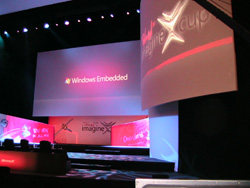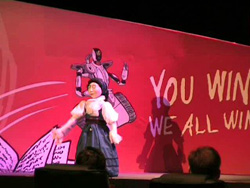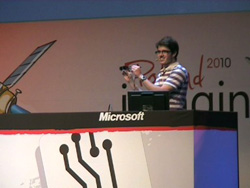WARSAW, Poland — July 8, 2010 — The stage was set and the excitement loomed. You could feel the nervous tension in the air as the finalists paced back and forth, practicing and fine-tuning their presentations. It was their last chance to impress the Imagine Cup judges.
The students had a big job to do Wednesday: present their project flawlessly and in front of the largest audience they have had yet. For many of the teams, they also had to present in their second language, making an already challenging task even more daunting.

The stage is set for final presentations in the Embedded Development category at Imagine Cup.
“These final six teams represent an amazing demonstration of innovative thinking and technical mastery,” said Scott Davis, group marketing manager for Windows Embedded and the Embedded Team captain.
“They have looked beyond the desktop and worked to build an embedded solution using both software development skills and hardware considerations. Today is the day they have to bring all this to life,” Davis said during Wednesday’s Imagine Cup competition.
Enter Stage Right
Korea kicked off the series of final presentations with Project RU Gentle, which aims to reduce the amount of CO2 released by vehicles and exacerbated by bad driving. Taiwan followed, demonstrating its SmarterMe solution that records power consumption within the home.
The Robonanny hit the stage next to show off some of its capabilities. This robotic doll was designed, built and carved by the hands of team MCPU from Russia.

Team Russia shows off Robonanny during final Imagine Cup presentations.
Kevin Pfister, who has become known as the U.K.’s “army of one,” hit the stage solo as the lone team member of eyeSight to present his solution Senses. This marked the first and only single-person team to participate in Imagine Cup competition.
To add to the pressure, contestants from Russia, Korea and the U.K. also participated in the Windows Embedded Unplugged session with worldwide media to provide additional insight into the hopes and dreams for their projects. During this session, Pfister took the opportunity to explain why he chose the Embedded category, saying, “The Embedded category really was the only choice for me. It provided me with the flexibility to do what I wanted to do.”
These three teams are also in talks with a number of investors. Korea was approached by a well-known car manufacturer, and the Robonanny has attracted interest from venture capitalists.

Team U.K.’s sole member presents to the judges in the final round of Imagine Cup competition.
This year, the judges are looking beyond the type of project developed and are interested more in how creative the technology is in solving the problem. The teams need to show they understand the technology, both the hardware and software, when introducing these new concepts and demonstrating usability and marketability. All these criteria are central themes the judges are looking for in Wednesday’s presentations.
Hailing from France, Team GERAS tackled challenging questions from the judges about their “intelligent carpet,” which is able to detect when someone has collapsed and notify emergency services accordingly. The team designed the carpet using special underlay flooring, they explained.
The projects are getting better and better each year, and as a result, the judges are expecting more. The competition is tougher, and this year’s finalists really have shown that they are the best of the best.
Team Romania closed the Embedded Development presentations with their EcoSynthesis project, but for all the teams the hard work doesn’t end here. This is just the beginning as they start working on the next phase of the project: taking on the judges’ feedback to turn their ideas into real-world solutions. For EcoSynthesis these next steps involved integrating location-based mapping and an SMS and e-mail alert system.
“These finalists have gone above and beyond. They have had to build their own operating system from scratch, they then had to build an application that runs on that system, and finally the hardware that runs that application. It’s an extremely impressive feat, what you’re seeing here today,” Davis commented. “The combination of their smart thinking, technical ability, passion and creative flare can be clearly seen in their projects.”
Although the competition element of Imagine Cup is now over, the judges embarked on a long night of deliberations to determine who will be crowned the heavyweight Embedded Technology Champion of the World.
Stay tuned for announcements on the winning team on the Windows Embedded News Center and @msftweb on Twitter. For additional Imagine Cup images, visit the Windows Embedded Flickr page and the official Imagine Cup Flickr page.




